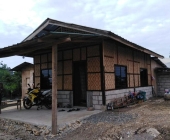




If we want clean food for the future, we must get off the chemical path of the past.




A human being should be able to change a diaper, plan an invasion, butcher a hog, conn a ship, design a building, write a sonnet, balance accounts, build a wall, set a bone, comfort the dying, take orders, give orders, cooperate, act alone, solve equations, analyze a new problem, pitch manure, program a computer, cook a tasty meal, fight efficiently, die gallantly. Specialization is for insects.
-Robert A. Heinlein
















Steve Marr wrote:I've treated thousands of bamboo culms, in most cases I use borax. The basics are similar to what has already been mentioned. One thing I suggest is to do more research from lots of different sources, rather than to start building with an unknown species. Here's some pointers:
- Identify the species, make sure it's suitable for building
- Cut mature culms (3+ years)
- Clean with scourers and detergents
- Drill through the whole length, to allow the borax to enter, so it can be absorbed
- Immerse in a 10% borax solution.
For building:
- Design in planes
- For joints, lash or drill holes and use dowels or threaded rod
I could add more info, but it's better you spend a couple of days reading, there's a lot of info on the net.




Leaching is the removal of sap after harvest. In many areas of the world, the sap levels in harvested bamboo are reduced either through leaching or postharvest photosynthesis. Examples of this practice include:
Cut bamboo is raised clear of the ground and leaned against the rest of the clump for one to two weeks until leaves turn yellow to allow full consumption of sugars by the plant.
A similar method is undertaken, but with the base of the culm standing in fresh water, either in a large drum or stream to leach out sap.
Cut culms are immersed in a running stream and weighted down for three to four weeks.
Water is pumped through the freshly cut culms, forcing out the sap (this method is often used in conjunction with the injection of some form of treatment).
In the process of water leaching, the bamboo is dried slowly and evenly in the shade to avoid cracking in the outer skin of the bamboo, thereby reducing opportunities for pest infestation.
Durability of bamboo in construction is directly related to how well it is handled from the moment of planting through harvesting, transportation, storage, design, construction, and maintenance. Bamboo harvested at the correct time of year and then exposed to ground contact or rain will break down just as quickly as incorrectly harvested material.

|
Surfs up space ponies, I'm making gravy without this lumpy, tiny ad:
montana community seeking 20 people who are gardeners or want to be gardeners
https://permies.com/t/359868/montana-community-seeking-people-gardeners
|




